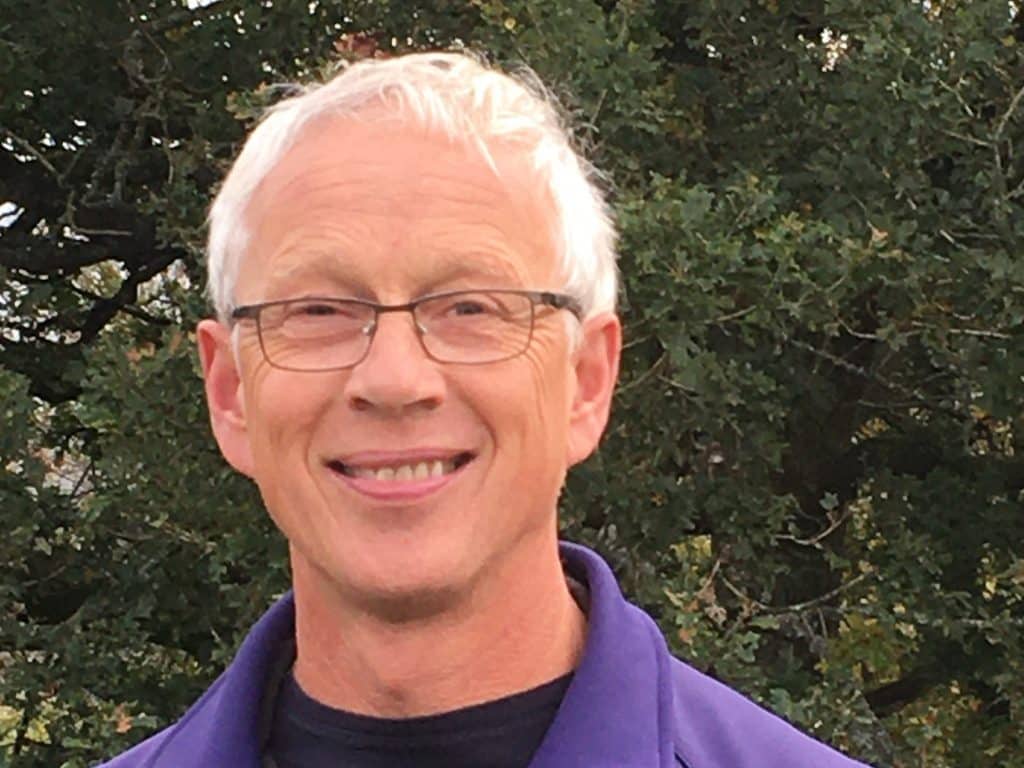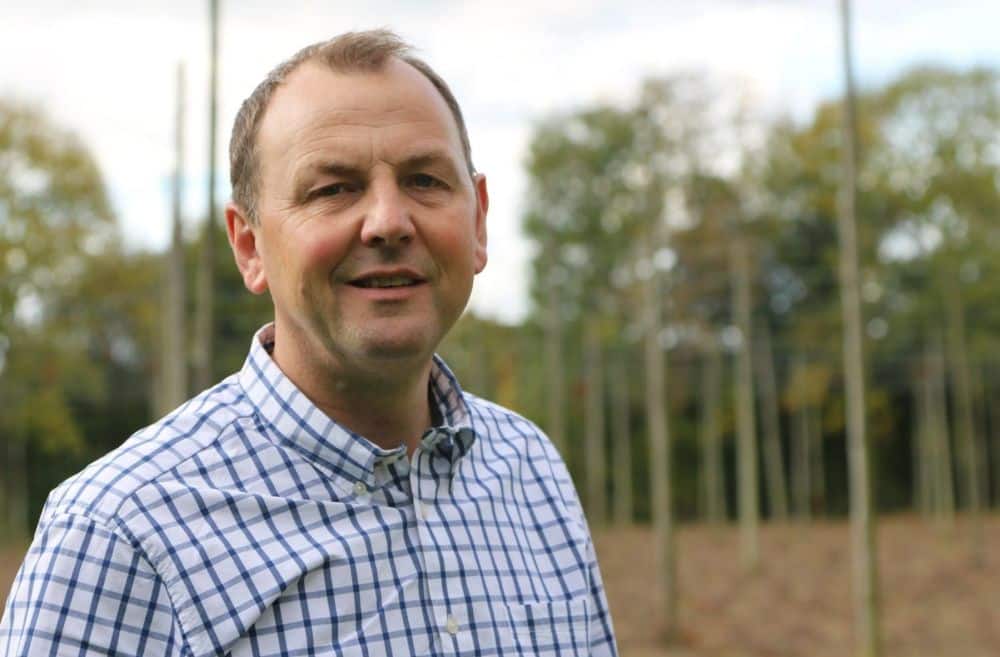Designs on light – The Fruit Grower
Hutchinsons is looking to challenge accepted wisdom about orchard management, from tree architecture to crop protection strategy, as Claire Shaddick discovered at an open evening at its Gloucestershire trial site...
A typical apple orchard wastes around 40% of one of its key inputs; that’s how much sunlight passes straight through the trees to the ground. Redesigning the canopy architecture so that the leaves intercept more light could, at least in theory, significantly improve yield and quality.
That’s the thinking behind an ambitious 10-year project by fruit agronomy company HL Hutchinson Ltd at two sites, in Gloucestershire and Kent. The Helios (Hutchinsons Enhanced Light Interception Orchard System) trees are also being pruned to be ‘robot ready’ with flat-plane canopies no more than 30cm deep to test the technology when it becomes available.
“It has been a huge investment,” says horticulture director Mike Hutchinson. “We wanted to do something that will have real benefit, to challenge some accepted wisdoms and learn from the planting schemes even where they haven’t worked. In the West Midlands in particular, we felt that there wasn’t a lot of research, despite the different soil and growing conditions here.”
Set up as a planting system demonstration, using Gala Galaxy across the board, other trials are also trying out new varieties, with an emphasis on earliness, and crop protection strategies. Growers were able to see some of the ideas being explored at a meeting in July at Helios West near Newent, Gloucestershire, which is managed by Nigel Kitney. A high-density alternate-leaning V-spindle set-up is one of the tree configurations under investigation. On M9, the in-row spacing is 50cm. Hutchinsons fruit agronomist Rob Saunders said that the plot was the most expensive to establish but had an exciting yield buildup, at 35.6 tonnes/ha in year three.

Nigel Kitney
M116 rootstocks are used for a ‘multileader laydown’ architecture because of its vigour and canker resistance. The main stem is grown to the top of the rabbit guard before being angled along the row at 20 degrees above horizontal with four vertical stems trained at 40cm apart. “There’s very little branching, and fruit forms close to each stem, so it should be easy to manage,” said Rob Saunders. “Once established, it only needs really simple replacement pruning.” In UK conditions 90 tonnes/ha is realistic for this system, he said, but in New Zealand, where it originates, yields for Braeburn on 1.6m rows are expected close to 200 tonnes/ha.
The most dramatic scheme is what Hutchinsons calls PV, taking its inspiration from photovoltaic panels that are angled for maximum light interception. The trees, on M9 or M116, are planted in an east/west row orientation, with the canopy sloping north at 50 degrees. In Kent, white Mypex was laid underneath to reflect light and improve fruit colour. “It’s probably not commercial, but we are hoping to learn more about tree plasticity,” said Rob Saunders.

Rob Saunders
With establishment costs a key factor in orchard viability, one trial alongside the Helios project is working on a way to reduce them. The low-cost orchard system uses the vigour of M116, with trees supported by a single horizontal wire on small stakes every 10m. “We’re already getting the height and lots of extension growth so we’ll probably have to root prune and use growth regulators to manage the canopy and get them into consistent cropping,” said fruit agronomist Andy Lloyd. “The lifetime of the orchard may only be 10-12 years, but as it’s a low-cost start-up, just start again within the 10 years and maybe even use the same trellis-work.”
M116 emanated from the same breeding programme as MM106, with similar vigour but less fibrous and with fewer surface roots, said nurseryman Nick Dunn. “Anchorage is good, and I suspect that moisture delivery to the tree is very even, even with fluctuating wet and dry periods,” he said. It’s also less susceptible to phytophthora and collar rot”. He believes that the industry should have switched to stronger, more vigorous rootstocks years ago, given the highly precocious scion varieties being used.
“M116 is more difficult to propagate but is one that we could use free-standing, with no support costs and with the right pruning on precocious varieties, the prospect for trees in this system could be better than 10 years.”
Mypex could be a potential weed management option for orchard rows should glyphosate be lost, so Hutchinsons is looking at a practical way of planting trees through the membrane. Roots of Gala Galaxy on Geneva 11 were cut off to around half an inch – ‘stringfellowed’ – and the stem bases pushed through the Mypex into a hole made with a spike. Planted last year, there’s no apparent difference to trees planted with their rootball intact. “Mypex lasts up to 10 years, so it could be a completely realistic way of managing an orchard without glyphosate,” said Rob Saunders.
With modern varieties being evermore scab-susceptible, and the range of scab fungicides ever more tightly squeezed, other products are needed that could help in an integrated management approach. There’s an increasing range of elicitor products that stimulate the trees’ natural defences, but there’s very little comparative data on them, Rob said.
More than 10 different elicitors are being compared in a replicated trial designed to find treatments that Hutchinsons would be confident of slotting into an existing programme. Elicitors can’t be used at the beginning of the season as the tree is still dormant. “Up to about pink-bud, we go in with conventional chemistry and then switch to elicitors,” he said. “Because we wouldn’t expect them to be utterly robust, we’ll set a disease threshold, relying on the elicitors to protect the trees for light infections. Some need time or repeated applications for resistance levels to build up, so we supported those with conventional fungicides until they have had a chance to take effect.” Initial assessments found some to be as effective as a full fungicide programme, while others “have done nothing at all.” He added: “We’re tracking what they’re doing to [other aspects of] tree health as well. Elicitors will contribute to the picture, but they won’t stand up in the face of a massive ascospore release.”
Hutchinsons has also taken the opportunity at its Gloucestershire Helios site to take part in larger scale projects that are supported by national funding agencies. For instance, the trial orchard is being used to find out how hyperspectral imaging technology can identify leaves affected with powdery mildew or scab before symptoms are visible. It’s part of the BBSRC-funded Red-Apple project that’s trying to better understand, and generate early warnings of, orchard diseases. Rob Saunders said that early trials with drones showed that the camera couldn’t get close enough. “The current thinking is to strap it to the front of a tractor so that as it moves through the orchard it’s looking at the foliage and doing the job of an agronomist in spotting disease before it gets going.”
Meanwhile, the practicalities of precision growth regulator or blossom thinner applications are being tested as part of an Innovate UK project that Hutchinsons is leading. “Even in the best orchards, the tree- to-tree variability can be huge,” said Rob. “When you decide on the rate of a thinner or a growth regulator, it’s a ‘one size fits all’ solution that doesn’t quite fit anything. How good an orchard could we make if every tree was the best, and what if we could treat trees as individuals, matching treatments to need for the control of vigour or blossom intensity?”
The approach starts with scanning the trees in winter by lidar, to measure the tree canopy. “It tells you how tall the trees are, where there are gaps, and a little about their vigour,” he said. In spring, a drone scans the orchard to photograph blossom intensity. Machine learning and Al interpret the images to create a prescription map to pinpoint trees with more intense blossom and those which are lighter.
A variable rate sprayer built by NP Seymour Ltd can apply individual treatments that match the spray dose to the tree, guided by the maps and GPS or RTK location. The first orchard trials began this year. While the focus is on growth control and fruit load there’s potential too for variable rate pest or disease treatments.
A window on what lies beneath
Precision agronomy soil scanning and mapping has tended to be associated with arable and broad-acre crops. But the top-fruit sector is becoming more aware of the potential benefits and the orchard hosting the Helios trial in Gloucestershire is among several in the area that have already been mapped using Hutchinsons’ TerraMap system. Its scanning technology, which derives all its data from measuring the variation in low levels of natural gamma radiation from four different mineral isotopes in the soil, is new to agriculture but was invented more than 50 years ago for minerals prospecting.
The scanner is mounted on the front of a lightweight vehicle. Hutchinsons uses a Honda Pioneer due to its weight, which is not much more than a quad bike, and because it’s small enough to travel between orchard, or even hop yard, rows. “We go along every second or third row, depending on your spacing, and it takes a scan every one or two seconds,” said Hutchinsons precision technology specialist Nick Strelczuk. “That gives us 800 data points/ha with measurements for up to 27 different soil parameters in just one pass.” While the scanner takes readings from the soil between the rows, a physical soil core sample is taken at various control points determined by the onboard computer and sent for laboratory analysis, the results from which are used to cross-check the scan data.
Measurements for each parameter are turned into individual map layers; one might show the pattern of variation in potassium levels across the orchard for example, another the differences in organic matter, or soil texture, or sand, silt, and clay proportions. “Your agronomist can help you use them to create planting or management plans,” said Mr Strelczuk. The results can also be linked to Hutchinsons’ Omnia Precision software, as well as an app for managing variable-rate nutrient applications, most likely with a view to improving productivity of poorer-performing orchard areas.
Hutchinsons offers the TerraMap service at a range of levels starting at £28/ha for P, K, g, pH, texture, and elevation; to £56/ha for all 27 possible parameters, including cation exchange capacity, organic matter, a wide range of micronutrients, and soil carbon content, recently introduced to the service.
“Quite a few growers have used the service where they have grubbed for replanting or been planning to plant in new fields,” said Mr Strelczuk. “The data can help with decisions on row direction, tree spacing, or even rootstock choice.”